Exploring the Malachite Geode: A Comprehensive Overview
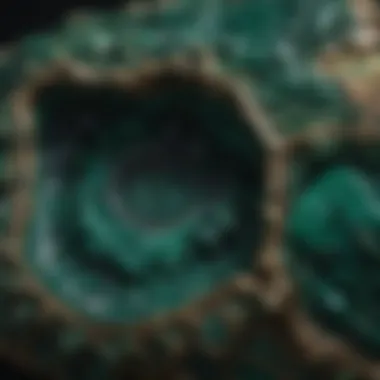
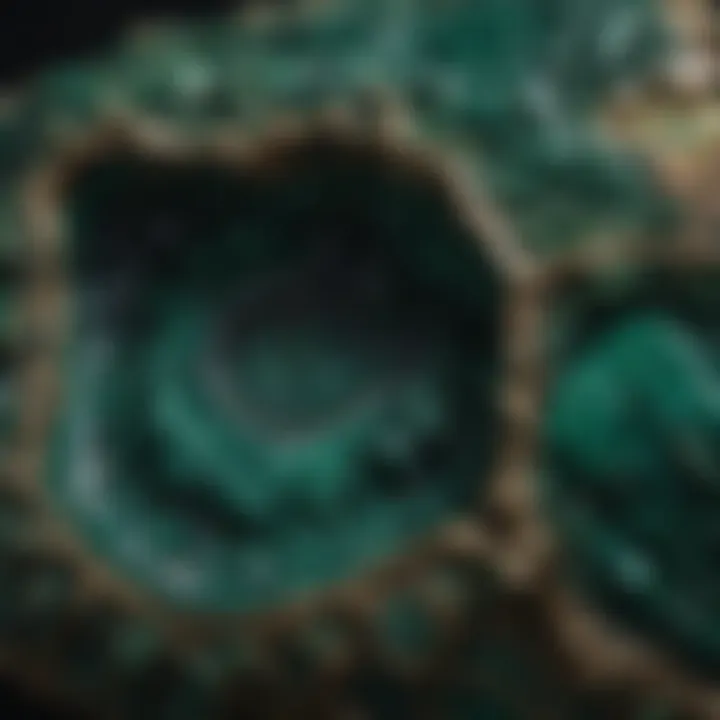
Intro
Malachite, a striking emerald-green mineral, does more than just catch the eye. Its beauty lies not only in its intricate banded patterns but also in its fascinating journey through time and beneath the Earth’s surface. This article takes you on an exploration of malachite geodes, shedding light on their origins, unique characteristics, and significance within both geology and various cultures. Whether you're a seasoned collector or just dipping your toes into the world of minerals, the insights presented here aim to enhance your appreciation for these captivating geological wonders.
History and Origins
Overview of Collectibles, Rocks, and Fossils
For enthusiasts, malachite geodes occupy a prestigious spot in the realm of collectibles. Before we delve into their specifics, it’s essential to paint a larger picture of rocks and fossils as collectibles. These items often carry stories of ancient Earth, and each piece is unique—much like a fingerprint.
- The Allure of Unique Specimens: Collectors seek after specimens that not only showcase beauty but also tell a story of formation and time.
- Malachite's Place in History: From ancient Egypt to modern-day collectors, malachite has piqued the interest of many due to its striking hue and metaphysical properties.
Historical Significance and Cultural Impact
Throughout history, malachite has donned many hats. In ancient civilizations, it was considered a protective stone, believed to safeguard against negativity and harm. The ancient Egyptians adorned their tombs with malachite, as it was associated with the goddess Hathor.
In the modern era, malachite’s cultural impact extends into jewelry and art. Its popularity surged when artists and artisans began incorporating it into intricate designs, from decorative boxes to mosaic pieces.
"Malachite’s vibrant green hue has not just made it a favorite among collectors but also a canvas for creativity spanning centuries."
Identification and Classification
Guide to Identifying Rocks and Fossils
To truly appreciate malachite geodes, an understanding of how to identify them becomes crucial. It’s not merely about the color but recognizing the specific features that distinguish it from other minerals:
- Color: True malachite boasts a rich green tone, often with darker and lighter banding.
- Texture: Its surface is somewhat smooth but can present a fibrous texture under certain conditions.
- Hardness: On the Mohs scale, malachite scores about 3.5 to 4, making it relatively softer than many other minerals.
Common Types and Variations
Malachite geodes come in various formations and types. Understanding these can be an edge for collectors:
- Botryoidal: This variation showcases a smooth, rounded appearance, resembling small grape-like clusters.
- Fibrous: Characterized by thin, needle-like growths, this type is often indicative of specific environmental conditions during formation.
- Stalactitic: Resembling stalactites found in caves, this formation occurs when mineral-rich water drips through rocks.
By recognizing these features, collectors can better navigate the market and identify what makes a particular piece special in both beauty and formation.
As we continue our exploration, we'll delve into the unique properties and care in maintaining these geological treasures.
Foreword to Malachite Geodes
Malachite geodes are not just mere stones; they represent a fascinating intersection of geology and art. Their vivid green hues and distinctive patterns have captivated collectors and enthusiasts alike. Understanding malachite geodes is essential for anyone venturing into the world of mineralogy or simply looking to appreciate the natural wonders around us. These geodes tell a story of mineral formation and transformation, inviting us to explore their meanings beyond the surface.
This section sheds light on two foundational aspects: the essence of malachite itself and the geode structures that house this remarkable mineral. Through a closer examination of these elements, we will gain insights into the broader context of their significance in both natural science and cultural artifacts.
Defining Malachite
Malachite is a copper carbonate hydroxide mineral, often recognized by its vibrant green color that can vary from light to dark shades. It occurs in botryoidal, fibrous, or stalactitic habits. The striking appearance of malachite stems from its layered texture, resembling intricate patterns reminiscent of the natural world's best artistry.
- Composition: Composed mainly of copper, with the formula Cu₂CO₃(OH)₂, malachite serves as an important source of this metal, playing a crucial role in various industries.
- Historical Significance: Malachite has been utilized since ancient times. Egyptians used it for pigment in makeup, while artisans crafted sculptures and jewelry from the mineral. These historical aspects contribute to its allure today and add depth to its identity.
In sum, defining malachite entails considering its chemical makeup, visual appeal, and the layers of human history woven into its fabric.
Understanding Geodes
Geodes, typically spherical rock formations, are nature's sculptures that house crystals, minerals, and even malachite. They are often found within volcanic and sedimentary rock formations, where mineral-rich fluids seep into cavities, leading to crystal growth over time.
- Formation Process: The development of geodes primarily occurs through geological processes like:
- Importance: Understanding geodes allows enthusiasts to appreciate the intricate journey these minerals take, from formation to exposure. This knowledge enhances the value of collecting, as every piece holds a unique story.
- Cooling Lava: As volcanic rock cools, it may create voids within which minerals crystallize.- Sedimentary Processes: Over millions of years, layers of sediment can form a geode when mineral-rich water deposits minerals in the hollow cavity.
Geodes serve as a window into the earth's processes, revealing the beauty that results from natural evolution.
In exploring malachite and geodes, we delve into an area rich with geological beauty and human appreciation, setting the stage for further inquiry into their formation and characteristics.
Formation of Malachite Geodes
Understanding the formation of malachite geodes is essential to grasp the beauty and complexity of these geological treasures. The processes involved in their creation tell the tale of the Earth’s history, revealing the intricate dance between minerals, water, and time. The appreciation of these formations is not merely academic; it connects us with the natural world, enhancing our understanding of mineralogy and the significant factors that contribute to the development of malachite geodes.
Geological Processes
Chemical Weathering
Chemical weathering significantly affects how malachite geodes come to be. This process involves the alteration of minerals through chemical reactions, often facilitated by agents like water and carbon dioxide. In the case of malachite, this weathering breaks down other minerals containing copper, which is vital for malachite’s formation.
One key characteristic of chemical weathering is its ability to leach out certain elements, leaving behind essential compounds. This selective removal is beneficial because it leads to a concentration of copper ions, the building blocks of malachite.
Unique Feature: The slow and steady nature of chemical weathering allows for the gradual creation of malachite geodes. Though this means the process takes time, the end result is a visually stunning formation with layered greens and textures that are often admired by collectors.
Advantages: Understanding this process helps mineral enthusiasts identify potential locations for finding malachite, as areas undergoing significant weathering often yield natural deposits. However, one disadvantage lies in the unpredictable nature of weathering, which can vary widely based on environmental conditions.
Hydrothermal Activity
Hydrothermal activity is another critical process leading to the formation of malachite geodes. This refers to the movement of heated water within the Earth’s crust, which can dissolve minerals and transport them. When these mineral-rich solutions cool, they can precipitate, leading to the crystallization of malachite.
A key characteristic of hydrothermal activity is the high temperatures and pressures that drive this dissolution and redeposition. This aspect is popular for collectors because hydrothermal veins often result in well-formed crystal structures, enhancing the aesthetic appeal of malachite geodes.
Unique Feature: The rapid cooling of hydrothermal fluids can create unique patterns and vibrant colors within the geodes, setting them apart from formations created solely through weathering.
Advantages: This process can lead to larger and more visually striking specimens compared to those formed by weathering. However, a disadvantage might be the geographic limitation of hydrothermal activity; it is often restricted to specific geological settings, which could make finding viable geodes challenging.
Crystal Growth Mechanisms
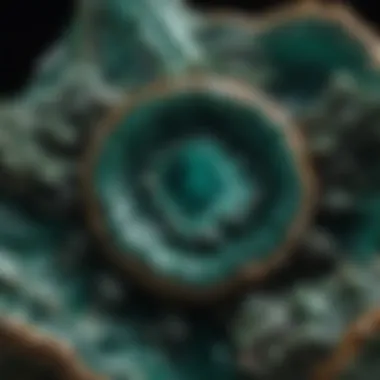

Nucleation
Nucleation is an essential mechanism in the overall formation of malachite geodes, defining the very beginning of crystal formation. This process involves the initial arrangement of atoms or molecules into a stable structure. In the context of malachite, it signifies the onset of crystal growth when conditions are right for malachite to precipitate from the surrounding solution.
One notable characteristic of nucleation is that it can occur spontaneously under the right conditions, which is beneficial for those looking to identify potential geode formations.
Unique Feature: The capacity for nucleation to happen at various scales means that both microscopic and more significant crystals can form, offering collectors a range of sizes and forms in malachite geodes.
Advantages: This spontaneous creation can lead to diverse compositions within the same geode, making each piece uniquely different. However, on the downside, nucleation is often a fickle process influenced by temperature and pressure, which can complicate predictions regarding when and where crystal growth will occur.
Crystallization Conditions
The conditions under which crystallization occurs are paramount in the development of malachite geodes. Factors such as temperature, pressure, and the saturation of the solution dictate how well crystals will form and the quality of the resulting mineral.
A critical aspect of crystallization conditions is that they need to be just right; if the environment is too saturated or too cool, the formation can be stunted. This aspect forms an important part of the article as it highlights the delicate balance required for optimal crystal development.
Unique Feature: Variations in these conditions can result in a range of colors, sizes, and patterns within malachite geodes, reflecting an almost artistic randomness to their formations.
Advantages: Studying these conditions offers insights into where collectors might find desirable specimens. However, the inherent unpredictability poses challenges, as not every eligible site will guarantee successful crystallization.
It's essential for collectors and enthusiasts to dive into the geological processes and growth mechanisms, as understanding these nuances enhances not only appreciation but also enhances successful collection practices.
Physical Characteristics of Malachite Geodes
The Physical Characteristics of Malachite Geodes play a crucial role in understanding these fascinating geological formations. Not only do they enhance the aesthetic appeal of the geodes, but they also provide important insights into their formation processes and environmental conditions during development. Collectors, geologists, and enthusiasts alike study these characteristics to identify quality specimens and gauge their value in both monetary and scientific terms.
Coloration and Texture
Layered Patterns
Layered patterns are one of the most distinct attributes of malachite geodes. These unique formations arise from the gradual deposition of minerals, leading to stunning bands of green that can vary significantly in shade. This characteristic does not just add visual allure; it also reflects the geochemical conditions present during the geode's formation. As water interacts with copper minerals over time, it leaves behind these colorful layers which tell a story of geological history.
The key characteristic of these patterns is their depth and variation; some geodes boast intricate swirl-like designs while others exhibit simple banding. This variability makes layered patterns an attractive choice for collectors who appreciate the natural artistry of minerals. Moreover, each specimen's unique features can enhance its market value, as enthusiasts often seek out well-defined layered structures.
However, it's worth noting that while these layered patterns are striking, they can sometimes be prone to chipping or wear if not handled carefully.
Surface Finish
The surface finish of malachite geodes can greatly affect not just their appearance but also their market desirability. Depending on how they are polished, the surfaces may exhibit a glossy sheen or a more natural, matte look. A high-quality polish can dramatically enhance the vibrant green coloration, making the geode more visually appealing.
A glossy finish tends to highlight the richness of the green hues and gives a modern touch, making these pieces popular among collectors and decorators alike. However, finding the right balance is essential, as overly polished specimens may lose some natural textural details.
On the flip side, a matte finish often appeals to those who favor a more organic look. This type of finish can preserve the natural patterns and textures, lending a rawer aesthetic that many find appealing. Both finishes have their merits, and the choice often boils down to individual preferences and intended display climate.
Size and Shape Variability
Common Forms
Malachite geodes can be discovered in a variety of sizes and shapes, each offering unique aesthetics and collectible value. The most common forms are typically round or oval-shaped, resembling small spheres nestled in stone. These shapes are particularly popular because they are visually striking and easy to display.
The key characteristic of these common forms is their symmetry, a trait that many collectors find appealing. This makes them a beneficial choice for those looking to create a cohesive collection or simply display beautiful specimens in their homes. Common forms often range from palm-sized to larger displays, which allows for diverse options in collection sizes.
However, one should be cautious as standard shapes are often more prevalent in the market. It may take extra effort to find truly exceptional specimens among these common forms.
Unique Specimens
Unique specimens of malachite geodes offer a fascinating twist on the usual descriptions. These can include irregular shapes, unusual sizes, or distinct color variations not typically seen in more common forms. Such pieces often capture the imagination of collectors and can command a premium price due to their rarity and one-of-a-kind nature.
The key defining factor of unique specimens is their individuality, setting them apart from the mass-produced varieties. This individuality makes them highly desirable to serious collectors who seek to differentiate their collections from others. However, the unique nature of these specimens also means that they can be more challenging to find, and when they do appear on the market, they often come with a higher price tag.
In summary, the physical characteristics of malachite geodes—layered patterns, surface finishes, size, and shape variability—are not just aesthetic elements; they serve as gateways into understanding the intricate layers of geology and history each geode embodies.
Geochemical Properties
Understanding the geochemical properties of malachite geodes is crucial for anyone involved in mineral collection or geological studies. These properties reveal not just the physical characteristics of the geode but also its formation processes, and the elemental composition influences everything from aesthetics to market value. The most significant aspects include mineral composition and chemical reactions—fundamental to the existence and appeal of these exquisite geological specimens.
Mineral Composition
Copper Content
One cannot discuss malachite without mentioning its high copper content. This particular aspect is like the cherry on top when appreciating malachite. The dense concentration of copper gives the geodes their striking green color, an element that draws in collectors and mineral enthusiasts alike. Copper, known for its conductive properties, also has historical significance; it has been utilized by humanity for tools and coins for thousands of years.
The key characteristic of copper in malachite is how it forms during the mineral's creation, aiding in the crystal structure. This is a notable point for collectors, as the purity of the copper affects not just appearance but also the overall quality of the geode. For instance, deeper-green specimens often indicate a richer copper concentration, making them more desirable. However, it’s essential to note that high copper levels can increase susceptibility to tarnishing, demanding careful handling and storage, which can be seen as a downside for some.
Associated Minerals
Malachite does not exist in isolation; rather, it often pairs with other minerals, enriching its story. Associated minerals like azurite, calcite, and quartz frequently accompany malachite geodes. This diversity contributes to both the visual complexity and the scientific intrigue.
The unique feature of these associated minerals is how they enhance the overall aesthetic appeal and provide insight into the geological history of the formation area. Each mineral adds a layer to the understanding of the environment where the geode was formed. However, having multiple minerals can complicate identification and influence the market value. Collectors may find that mixed specimens exhibit a lower price compared to pure malachite, despite their unique aesthetic.
Chemical Reactions
Oxidation Processes
The oxidation processes connected with malachite geodes are profound. As copper minerals weather and oxidize, malachite forms from the secondary alteration of copper-bearing minerals in a process that highlights the dynamic nature of geological change. This characteristic stands out as it underscores how malachite itself is a product of environmental interactions, marking the geode as not just a beautiful item, but also a historical record.
The benefit of understanding these processes lies in appreciating the conditions under which malachite develops. Often, clear geographical and climatic factors will lead to variations in malachite’s appearance, adding a layer of depth for savvy collectors. However, one should keep in mind that inherent oxidation can lead to structural weakness over time, an important consideration for care and preservation.
Interactions with Other Minerals
Interactions with other minerals are an important aspect of malachite’s chemical properties. Geodes are not standalone entities; they reflect a history of mineral interactions that create intricate formations. For example, interactions between malachite and nearby iron compounds can produce stunning color variations. This aspect is beneficial as it allows for an exploration of not just malachite but the surrounding geological environment.
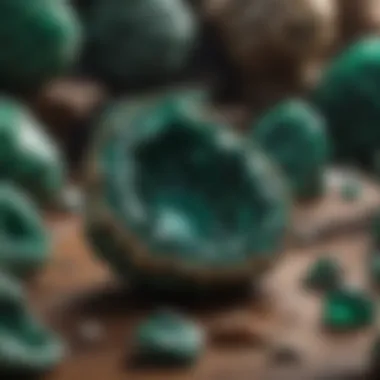
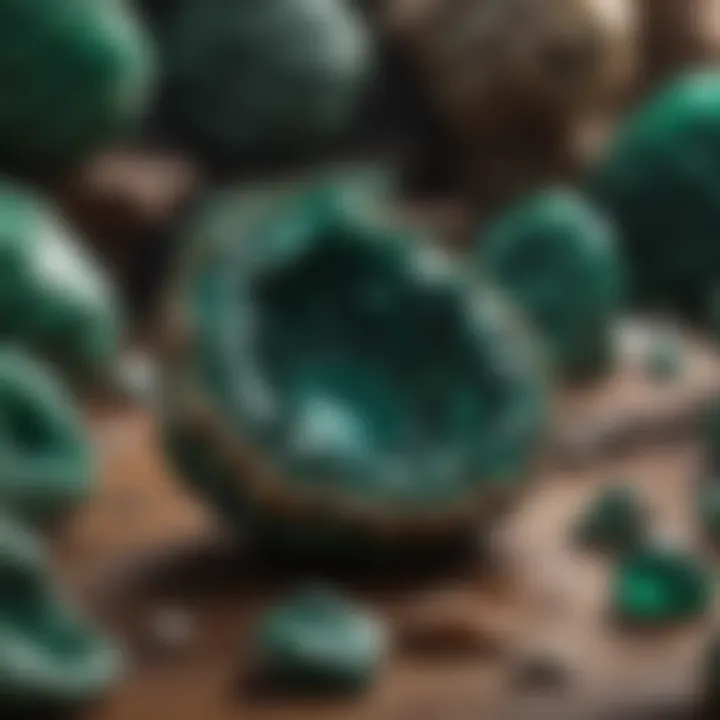
The key characteristic of these interactions offers insight into the complex chemistry at play in various environments. For collectors, unique interactions can signify the geode’s origin, adding value. Yet, these interactions may also lead to complications such as contamination or weakening of the malachite structure, which necessitates careful consideration during collection and display.
Understanding the geochemical properties of malachite geodes enriches both appreciation and knowledge. It leads collectors not just to admire their beauty but also to explore the fascinating journey these minerals have taken from formation to display.
Identifying Malachite Geodes
Identifying malachite geodes is crucial for enthusiasts and collectors seeking to appreciate these unique geological formations. It involves recognizing their distinctive visual traits and understanding how to differentiate them from other minerals. Mastering these identification skills not only enhances one’s collection but also improves the overall appreciation for the complexities of geology.
Field Identification Techniques
Visual Characteristics
Visual characteristics play a significant role in identifying malachite geodes. One of the first things to look for is the striking green color, typically varying from pale green to a vibrant hue that shimmers under light. Another key characteristic is the banded appearance, which often resembles waves of emerald green. This layered pattern develops during the crystallization process, making it easier to spot these geodes among other specimens. The opacity of malachite can also be a distinguishing factor, often appearing somewhat translucent.
A unique feature of the visual characteristics is the fine layering that can be observed when viewing a fractured surface. These layered edges reveal the interior beauty of the geode, telling a story of its formation. Recognizing the texture is also essential—malachite often exhibits a smooth, polished surface. However, field specimens might appear rocky and rough, emphasizing the importance of careful observation.
Such visual traits make malachite geodes a popular choice for collectors, as the aesthetic appeal is immediately captivating. However, confirming authenticity through visual cues can sometimes be tricky; not every green mineral is malachite, as some other materials might mimic its appearance.
Handling and Testing Methods
Handling and testing methods are vital to accurately identifying malachite geodes. An essential aspect of this process is the feel of the mineral. Real malachite is relatively heavy for its size due to its copper content, and a simple weight test can help distinguish it from lighter impostors. Additionally, a scratch test might reveal its medium hardness on the Mohs scale, ranging from 3.5 to 4, allowing for further verification.
A unique feature of handling these geodes is the need for care. Oils from human skin can alter the surface, so it's best practice to wear gloves when examining specimens closely. This safeguarding extends not just to the mineral’s integrity but also to its luster.
Caution should be exercised, however; some handling techniques could accidentally damage a specimen. For example, excessive pressure could chip the delicate layer. Knowledge about the interaction of malachite with acids is also beneficial, as this reaction can indicate the authenticity of the mineral.
Scientific Tools and Methods
Scientific tools and methods further enhance the identification process, providing deeper insights into the malachite's structure and properties.
X-ray Diffraction
X-ray diffraction (XRD) serves as a powerful tool in identifying malachite geodes with precision. This method allows for the determination of crystal structure and phase identification. By directing X-rays onto a sample, one can capture the unique diffraction pattern that represents the mineral's atomic arrangement, which is quite distinct for malachite.
The ability to analyze the crystal structure through this technique makes X-ray diffraction a crucial choice for serious collectors and researchers alike. The unique feature of obtaining a fingerprint of the mineral at an atomic level provides undeniable proof of its identity. However, access to the necessary equipment and expertise in interpretation can be a barrier for some, making it less accessible to the casual collector.
Microscopic Analysis
Microscopic analysis adds another layer of scrutiny in identifying malachite geodes. Using a polarizing microscope, observers can discern the mineral's texture and optical properties in great detail. This method allows for a close examination of grain size and shape, which can be invaluable in distinguishing malachite from similar minerals.
One key characteristic of microscopic analysis is its non-destructive nature, meaning it does not damage the specimen. This feature is particularly beneficial for collectors who wish to preserve their specimens for display or future research. While it may require some financial investment for equipment, the insights gained from microscopic examination can enhance an enthusiast's understanding significantly.
Understanding how to properly identify malachite geodes increases not only the likelihood of adding genuine specimens to one’s collection but also enriches the context in which these remarkable minerals are studied and appreciated.
Caring for Malachite Geodes
Caring for malachite geodes is not just about preserving their beauty; it's about understanding the delicate nature of these geological wonders. Proper care ensures that these specimens can be appreciated for generations, as they can be sensitive to environmental factors and improper handling. Keeping their unique features intact allows collectors to enjoy their intricate beauty and ensures their scientific value remains intact as well.
Cleaning Procedures
Safe Minerals to Use
When it comes to cleaning malachite geodes, using safe minerals is vital. You want to avoid any harsh chemicals that could diminish the stone’s vibrancy or, worse, damage it permanently. Mild soap, soft water, and natural cleaning agents like vinegar can be effective without being abrasive. The key here is to maintain the geode’s vibrant green hue and layered facets by using materials that are gentle on its structure.
A unique feature of this approach is that many collectors use a simple cloth dampened in a solution of these safe minerals. This minimizes wear while allowing you to remove dirt or dust without fear of scratching the exquisite surface. It’s beneficial for both the aesthetic and the preservation of the stone, keeping its lustrous effect alive.
Methods to Prevent Damage
Preventing damage is just as crucial as the cleaning process itself.
Storage solutions play a large part here. For instance, ensuring malachite geodes are kept away from direct sunlight can prevent fading of their color. Moreover, placing them in padded boxes or soft cloth pouches can help avoid scratches from other items. A distinctive advantage of using these methods is that they help to create a safe environment, minimizing external impacts.
Also, it’s advisable to regularly check for any signs of moisture accumulation, since malachite is susceptible to damage when exposed to excess humidity. Keeping an eye on the conditions of where your geode is placed is an uncomplicated but effective method of care.
Display and Storage Strategies
Environmental Considerations
Environmental considerations are often an afterthought, yet they hold significant weight in the care of malachite geodes. These geodes will flourish in a stable environment; ideally, they should be displayed in temperature-controlled spaces to avoid thermal shock or any potential cracking.
Moreover, the stability of humidity levels is paramount. High humidity can introduce moisture-related problems, while overly dry conditions could lead to surface degradation over time. Investing in a monitoring system for these factors is worthwhile, as the right balance keeps your specimens safe and visually appealing.
Best Practices for Displaying
When it comes to displaying malachite geodes, best practices can make all the difference in how they're perceived and maintained. A well-considered arrangement can showcase their beauty while also protecting them.
Ideally, they should be placed on a stable, cushioned base – keeping them elevated off hard surfaces limits vibrations that could break them or cause chips. Adding some soft background lighting can highlight their striking features without exposing them to direct light, which may cause discoloration over time.
Here’s a short checklist for best practices:
- Use soft cloths and cushions beneath geodes
- Avoid exposure to direct light
- Rotate their positions periodically to prevent uneven wear
By adopting these strategies, the lifespan of your beloved geodes can be extended, ensuring that they continue to inspire admiration and wonder well into the future.
Malachite in Culture
Malachite has captivated human imagination for centuries, not just for its striking appearance, but also for its historical significance. This green mineral has found its way into various cultures and practices, illuminating a tapestry of beliefs, artistry, and traditions. The exploration of malachite's cultural journey reveals how deeply intertwined this mineral is with our history and values.
Historical Uses
In Ancient Civilizations
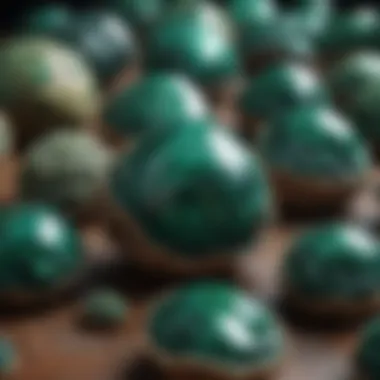
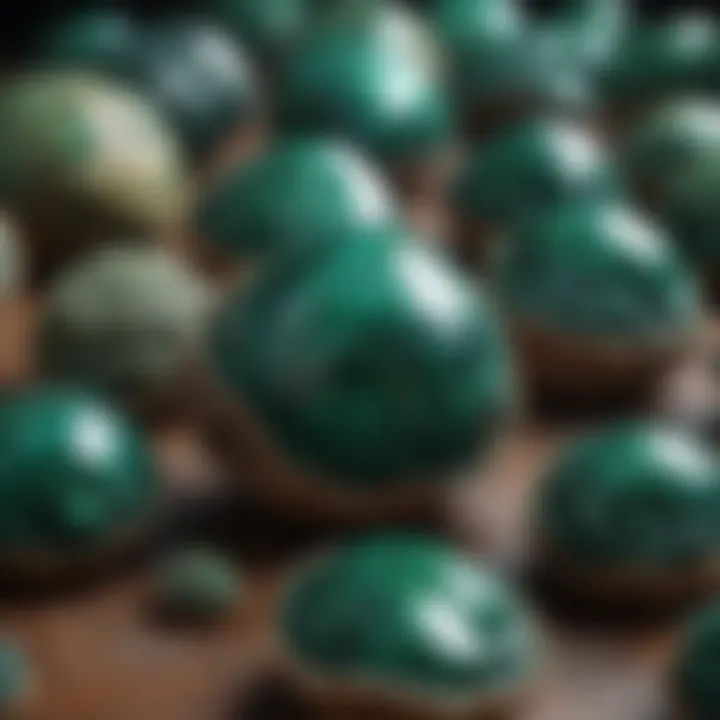
In the days of yore, malachite held a special place in ancient civilizations, notably among the Egyptians and Greeks. This mineral was not merely an aesthetic choice; its vibrant green color was symbolic of fertility and rebirth. The Egyptians believed that malachite had protective qualities, and they often ground it into powder to create eye shadow, known as kohl, which they applied to ward off the evil eye.
Key characteristic: Malachite provided both decorative and spiritual utility, making it a dual-purpose mineral in antiquity. Its reliability as a pigment, paired with its visual allure, contributed to its popularity among artisans, especially in jewelry and ornaments. Its unique feature lay in its ability to blend practicality with beauty, ensuring it's a sought-after material for sculptures, amulets, and inlay work.
However, the mining and extraction of malachite often came with its downsides. Early miners risked exposure to toxic dust, which could present health challenges over time. Despite that, the benefits far outweighed the disadvantages, as malachite became a revered commodity valued by royalty and merchants alike.
As Artifacts and Jewelry
Malachite's allure doesn't stop at beauty; it has also been expertly crafted into artifacts and jewelry, telling tales of craftsmanship and artistry. The ancient skills of lapidary artists allowed for the creation of exquisite pieces that blended malachite's swirling greens with intricate metalwork. These pieces served as status symbols, displayed not only wealth but also the owner's connection with the divine.
A key characteristic that stands out is the range of vibrant green hues that make up malachite, each piece unique in its patterns. This uniqueness lends itself well to custom jewelry making, appealing for those seeking personal adornment. Notably, malachite beads were woven into necklaces and bracelets, believed to carry protective energies. The craftsmanship embedded in these artifacts often tells the emotional stories of cultures long gone.
One could argue that while the beauty of malachite attracts collectors today, its historical significance carries a weight that cannot be overlooked. The value of these artifacts in terms of cultural heritage is immense; however, the delicate nature of malachite can be a disadvantage. Exposure to sunlight and harsh chemicals can deteriorate the stone, making care and conservation vital to preserving these links to our past.
Contemporary Significance
In modern society, malachite embodies a blend of tradition and contemporary relevance. Its aesthetic qualities are matched by its spiritual and decorative uses, appealing to various demographics — from collectors to spiritual practitioners.
Spiritual Beliefs
In today's world, many still turn to malachite for its purported spiritual properties. Believers claim that malachite is a powerful stone for transformation, assisting in emotional healing and personal growth. Its color is often associated with the heart chakra, promoting love and compassion.
The key characteristic is its role as a healing stone, making it a popular choice for crystal enthusiasts and therapists. Many practitioners recommend it for meditation, suggesting that it helps remove blocks and encourages positive energy flow. Notably, those using malachite in spiritual practices often cite its grounding qualities, allowing individuals to connect deeper with their inner selves.
However, the use of malachite in spirituality might have its challenges. Some may be skeptical of its efficacy, noting a lack of scientific evidence behind these beliefs. Still, the popularity of malachite as a spiritual tool persists, showcasing its continued importance in contemporary culture.
Modern Decorative Uses
Today, malachite is frequently employed in home decor, furniture design, and artistic expressions. Its rich colors add a touch of elegance, making it a favored choice for tabletops, inlays, and decorative items. Interior designers may opt for malachite accents in homes and establishments, aiming to infuse spaces with a sense of luxury.
The beauty of modern decorative uses draws from malachite’s unique feature of distinctively layered patterns that cannot be replicated by artificial means. This characteristic makes it an exclusive choice, appealing to those wishing to make a statement with their decor. Nonetheless, the challenge remains in sourcing quality pieces at a reasonable price, with authentic malachite often fetching high market values.
Despite the challenges, the decorative utilization of malachite enriches not only living spaces but also cultural appreciation, ensuring that this gem continues to hold a place in the essence of human experience.
As we unravel the layers of malachite, we find it is not merely a geological specimen but a bridge connecting us through culture, history, and spirituality.
Economic Aspects of Malachite
The economic dimensions of malachite extend beyond its beauty, weaving a narrative through industry and culture. This section delves into the financial significance of malachite geodes, looking precisely at mining practices, market fluctuations, and the broader implications for enthusiasts and collectors alike.
Mining and Extraction
Global Mining Locations
Mining for malachite occurs predominantly in countries rich in copper resources. Notably, the Democratic Republic of Congo, Zambia, and Russia stand out as prominent sources of high-quality malachite geodes. Each of these locations provides a unique blend of mineral deposits that contribute to the global supply.
The DRC, in particular, is known for its vast reserves and colorful specimens. This area is advantageous due to its favorable geology and often relatively lower mining costs compared to other regions, making it a beneficial source for collectors searching for vibrant green varieties. Yet, this comes with challenges. The socio-political circumstances in the region can sometimes hinder operations, raising questions about sustainability and ethical sourcing.
Extraction Techniques
Extraction methods for malachite often involve traditional and modern techniques. Small-scale artisanal mining is common in regions like Zambia, where locals use hand tools to extract malachite from the earth. This method allows for manual selection of high-quality specimens but can be labor-intensive and potentially hazardous, given the lack of safety protocols.
On the other side, larger operations may employ more sophisticated techniques, such as open-pit mining. This method allows for significant extraction volumes and minimizes waste. The downside? Open-pit mining can result in considerable environmental destruction, leading to loss of habitat and landscape alteration. Striking a balance between efficient extraction and environmental stewardship is a constant challenge in the industry.
Market Value and Trends
Factors Influencing Pricing
Malachite's market price fluctuates based on several factors, including rarity, quality, and demand in both ornamental and industrial markets. High-quality, finer specimens can fetch a premium, particularly those with unique patterns and sizes. The increasing trend towards sustainable sourcing is also affecting prices. There’s a growing consumer preference for ethically sourced minerals, which can elevate costs for producers adhering to these standards while driving those that don’t to cut corners.
Understanding market dynamics, such as shifts in interest from collectors or changes in industrial use, can significantly influence investment decisions. Monitoring these trends can be crucial for collectors aiming to purchase or sell specimens at the right time.
Future Trends in the Market
Future trends indicate a potential rise in malachite's value as awareness around sustainable and ethical practices grows. As more collectors begin to prioritize eco-conscious choices, demand for responsibly sourced malachite may soar. Furthermore, advancements in technology and education about the mineral may lead to newer applications, such as its use in alternative energy or advanced materials.
Just as important, economic shifts in producing countries can affect global pricing. Investors and collectors looking sharply ahead must keep a finger on the pulse of both local economies and global markets to anticipate changes. As trends evolve and collectors become more educated, malachite's role both as a gemstone and commodity is bound to expand.
In summary, understanding the economic aspects of malachite geodes provides valuable insight into their significance in both personal collections and the mineral market. Mining location characteristics and extraction methods coupled with market forces and sustainability considerations shape the future landscape for malachite enthusiasts.
The Future of Malachite Geodes
The future of malachite geodes appears to be an unfolding saga, filled with both challenges and opportunities. As enthusiasts in the field of geology and mineralogy continue to explore the depths of these fascinating formations, it becomes increasingly clear that research and technological advancements play pivotal roles in understanding malachite's past, present, and future. The vital aspect of sustainability comes into play, ensuring that appreciation for this natural wonder aligns with environmental stewardship. By focusing on specific elements such as research advancements, technological innovations, and environmental considerations, we can gain a clearer picture of what lies ahead for malachite geodes.
Advancements in Research
In Geology and Mineralogy
Research in geology and mineralogy is expanding, shedding light on the processes that lead to the formation of malachite geodes. Recent studies have explored the various geological settings where malachite is found, providing insights into its formation and properties. This emphasis on research is valuable in understanding the broader context of mineralogy and how malachite fits into the greater mosaic of geological history. A key characteristic of this research is its focus on not just the mineral itself, but also on the surrounding ecosystem and its impacts on malachite formation. However, comprehensive studies do come with challenges, such as the need for funding and the access to remote mining locations, which can create limitations.
Technological Innovations
Technological innovations are revolutionizing how researchers and collectors interact with malachite geodes. Advancements in methods such as scanning electron microscopy (SEM) and laser-induced breakdown spectroscopy (LIBS) allow for a deeper analysis of the mineral's structure and composition. These technologies are essential tools that further the exploration of the intricate details found within malachite. An impactful feature of these advancements is the ability to conduct studies with minimal disturbance to the samples, preserving their beauty and integrity. While these tools make investigation more precise, they can also be quite costly and require specialized knowledge to operate effectively, which is a consideration for both researchers and enthusiasts looking to deepen their understanding.
Environmental Considerations
Sustainable Practices
As the demand for malachite geodes grows, implementing sustainable practices in mining and collection is crucial. Sustainable mining ensures that the extraction process does not deplete resources beyond recovery while minimizing ecological disruption. These practices are beneficial because they support the long-term availability of malachite while protecting the ecosystem. Emphasizing responsible sourcing can lead to a better reputation for the mineral market, appealing to environmentally conscious consumers. However, one challenge remains the balancing act between meeting demand and adhering to strict sustainable practices, which can sometimes limit production rates.
Impact of Climate Change
Climate change presents both direct and indirect challenges to malachite geodes. Changes in temperature and precipitation patterns can affect the geological conditions under which malachite forms, possibly altering the characteristics of newly found geodes. It becomes essential to monitor these shifts closely to understand their implications for both geology and the mineral market. An important characteristic of this issue is the unpredictability of climate impacts on natural resources. While recognizing this phenomenon may contribute to a greater awareness within the community, not all collectors are fully informed of these long-term consequences, which may lead to misinformed decisions.
"Sustainability isn't just a trend; it’s a necessity for preserving our geological treasures for future generations."
Understanding these interconnected facets offers valuable insight into the future of malachite geodes. By prioritizing research, integrating technological advancements, and implementing sustainable practices while remaining aware of climate change's potential impacts, the appreciation of malachite can evolve into a balanced pursuit of beauty and responsibility.



